
Staying on target: Fall election looms as federal infrastructure plan progresses in fits and starts
By David Kennedy
Bridges Construction Financing Infrastructure P3s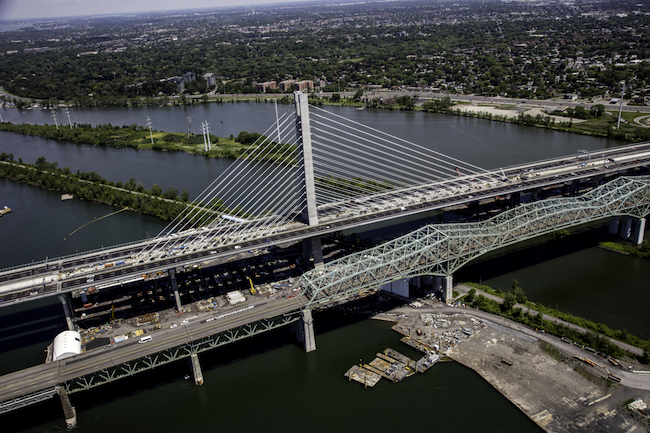
The new cable-stayed bridge will is designed to stand 125 years. PHOTO: Infrastructure Canada
In the early morning hours of June 24, a few minutes before sunrise, a small convoy of cars drives slowly across the freshly paved asphalt deck of Montreal’s new Samuel de Champlain Bridge.
With the deep blue of twilight still dominating the sky, the official first crossing of the 3.4-kilometre span marks the end of just over four years of dedicated work to replace the aging cantilever bridge now sitting in its modern counterpart’s shadow.
At peak, about 1,600 workers were on-site assembling the new bridge, which is expected to stand 125 years, twice as long its relatively short-lived predecessor erected in the 1960s. With a striking cable-stayed design that employs 600 box-girders and a main pylon extending 170 meters (nearly 560 feet) above the St. Lawrence River, the new bridge was a monumental undertaking.
As it so often is with major infrastructure work, however, meeting expectations is easier said than done.
The bridge opened to traffic six months behind schedule and about $235 million over its original $4.2 billion budget.
A few final pieces remain, most notably the reconfigurations of several highway links and the bridge’s central pedestrian and cyclist path, but all work is scheduled to wrap up by the end of October.
Though it was sanctioned in 2015, before the introduction of the much-touted Investing in Canada Plan (IICP), the Champlain Bridge has been among the largest infrastructure jobs underway across the country in recent years.
Still, as the federal infrastructure plan has picked up steam, crews in Montreal have had plenty of company in cities and towns across the country. Ottawa has put shovels in the ground or allocated funding for 48,000 separate projects since the outset of its wide-reaching infrastructure plan in 2016, with many more to come. All told, the federal government has spent or allocated $42.3 billion for infrastructure work, according to the most recent available data released this May.

The aging steel truss cantilever bridge will be torn down over the next several years. PHOTO: Infrastructure Canada
“One-quarter of the way through the plan, the government has invested more than one-quarter of its commitments to communities,” Infrastructure Canada says in a statement. “That’s on time and on track.”
Initially introduced as a $180 billion plan, several years of revisions and additions have seen that figure climb to approximately $190 billion.
Among the high-profile projects already funded are subway extensions in Vancouver and Montreal, and new light rail transit lines in Calgary, Edmonton, Montreal, Toronto and Surrey, B.C. While multibillion-dollar transit projects dominate the top end of the list, the federal funding is available for everything from small-scale wastewater and sewer upgrades to local hockey arenas.
THE BIG PICTURE
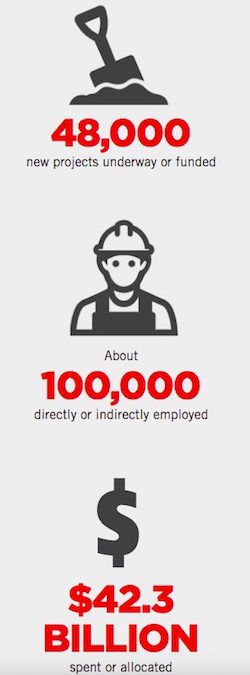
The 12-year infrastructure initiative has helped kick-start thousands of projects, but it’s also faced challenges meeting its targets from the outset.
In Budget 2019, released this spring, the federal Liberal government admitted, “The pace of spending under the Investing in Canada Plan has been slower than originally anticipated.” For the delays, it blamed lapses between construction activity and claims for federal dollars, as well as “some” jurisdictions for being slower to move on projects than expected.
The plan has moved undeniably forward, but the progress has not always been smooth.
In last year’s budget, for instance, Ottawa pushed back billions in funding originally allocated for between 2018 and 2024 to the tail end of the 12-year plan. The funds remain on federal books, but won’t be spent until well into the next decade. This year, the government announced a one-time, $2.2 billion top up to the Federal Gas Tax Fund, which is doled out to pay for municipal infrastructure. The move gave cities a shot in the arm while skirting the provinces, which Ottawa has accused of holding up spending.
Moving forward, it’s clear the federal government must work more closely with other levels of government and Indigenous communities, which together own more than 98 per cent of all Canadian public infrastructure, to ensure a more consistent flow of funds. It tacitly admitted this in February by simplifying the application process and creating a new online portal for submissions.
Since implementing these changes, Infrastructure Canada pointed to a new water treatment plant in B.C.’s Comox Valley and new internet service infrastructure in Quebec’s Laurentian region as two examples of how the better streamlined approval process has translated into results.
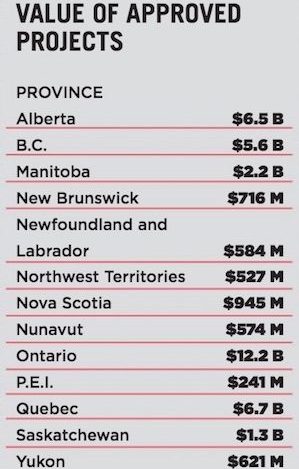
LOOKING FOR TRACTION
As funds continue to leave government coffers, the Canadian Construction Association (CCA) remains firmly behind the spending plan, but would like to see more progress.
“What we are concerned about is the flow of funds and that it is taking longer than really anybody could have imagined — particularly the wave two of the investments, which were set out in 2018,” says CCA President Mary Van Buren. “As of right now only two provinces, B.C. and Alberta, have commitments of greater than 50 per cent of the funds in place [for Phase 2] and the remaining provinces range everywhere from zero to about 25 per cent.”
Still, Van Buren admits that with such a complex process, the fixes aren’t always simple. “There’s no silver bullet,” she says. “One of the lessons out of this is just how much time it takes to get municipalities ready. So, it’s one thing to put money on the table, it’s another for the municipalities to put together their project plan, then to get them approved by the province, to get them approved by the [federal] government, then go through the whole procurement process, choose their partners and then put the shovels in the ground.”
Taking note of some of the issues that have hampered the 12-year plan, the CCA has begun pushing Ottawa to lay the groundwork even further ahead next time around. A 25-year plan would take into account how long it takes to get the building cycle working, Van Buren says. The longer-term commitments could also smooth out some of the usual turmoil that follows government turnover.
Matt Jeneroux, the federal Conservative shadow minister for Infrastructure, Communities and Urban Affairs, is less forgiving in his analysis of the first few years of the Liberal spending plan.
“I don’t know of any stronger adjective to say than it’s been a complete failure of a plan,” he says, pointing to lots of “hype” but too many delays and not enough focus on rural communities.
“I just think the government’s had four years to, they say, build infrastructure and it seems to be shifting to a message of hope and aspiration in the first two years and now basically a message of blaming provinces and anyone else that seems to get in the way,” Jeneroux says.
Unsurprisingly, Infrastructure Canada sees things differently. The department says it’s made “significant progress and delivered concrete results” that have benefited Canadians across the country since 2016, adding that it sees building modern, resilient and green infrastructure as a “generation-defining challenge.”
“The government will continue to work in partnership with provinces, territories, municipalities and Indigenous communities… to ensure that they have the transformational infrastructure they need to build strong, resilient communities, while creating new economic opportunities for Canadians,” the department says.
THE $35 BILLION QUESTION
One long-idle piece of the Liberal infrastructure plan that finally dropped into place 12 months ago was the Canada Infrastructure Bank (CIB).
The crown corporation designed to draw private investors into spending on infrastructure made its first move last August, loaning Montreal’s Réseau express métropolitain (REM) project nearly $1.3 billion. It followed that up by extending a $2 billion debt financing package to the Toronto-area’s GO Regional Express Rail On-Corridor project this May. Even more recently, it made two smaller investments of $55 million and $20 million in Ontario and Quebec.
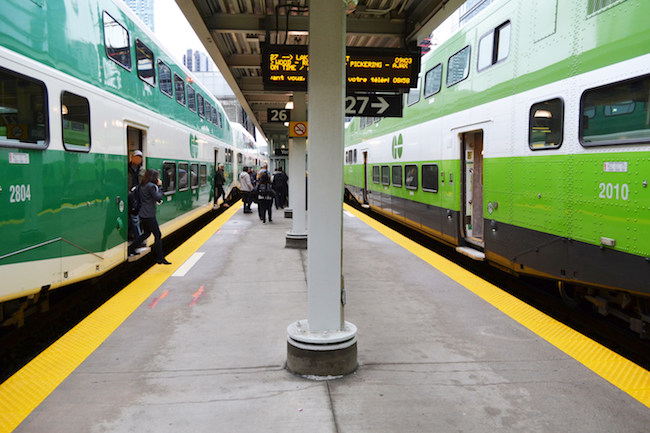
Debt financing for Ontario’s GO Transit expansion is one project green-lit by the CIB. PHOTO: CIB
Nevertheless, critics remain skeptical. With a $35 billion investment target by 2028 and only several billion doled out so far, the CIB needs to get moving. Jeneroux notes that the bank — with its focus on getting private capital involved in infrastructure — was one aspect of the IICP the Conservative Opposition initially saw as promising.
“It looked like it was going to be a unique way to infuse private money into infrastructure and get things built,” he says. With the institution now established, however, Jeneroux is critical of the CIB’s added mandate of concentrating on “transformative” projects and its focus — at least so far — on urban projects and not rural communities.
Van Buren, meanwhile, is keen to give the fledgling bank more time.
“It’s just getting going and starting to figure out its role and how it can help de-risk some of these very complex projects,” she says. “We think that’s really important to continue.”
While the Liberal’s public infrastructure commitments, the CIB included, played an important role in the 2015 election campaign, at this early stage of the 2019 race, highways, bridges and sewers appear more likely to be a backburner issue.
Private infrastructure, on the other hand, may play a starring role.
TESTING THEIR RESOLVE
Energy infrastructure, most notably pipelines, has been a divisive issue across Canada for years.
Proponents of new pipelines argue they are vital to Canada’s economy, while critics claim the risk of spills and the downstream carbon emissions created by crude oil or natural gas transmission systems run counter to the country’s interests.
The years-long battle over the project to twin the Trans Mountain pipeline between Edmonton and Burnaby, B.C. encapsulates the stark divide.
The federal government purchased the pipeline last summer with plans to move forward on the project. The Federal Court of Appeal then quashed the approval in August 2018.
A year later, the pipeline has been reapproved, but with construction poised to restart, opposition groups are preparing to launch fresh challenges.
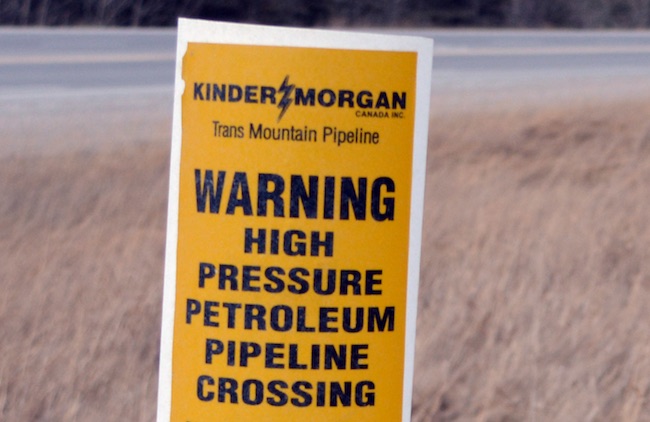
The pipeline twinning project has been halted and reapproved numerous times. PHOTO: Trans Mountain
The reapproval of Trans Mountain and the ramp up of construction on an approximately $40 billion liquefied natural gas facility in Kitimat, B.C. are encouraging signs from a construction standpoint, but if the past few years of court challenges are any indication, neither project can be considered entirely in the clear.
By backing the pipeline, but also remaining committed to a carbon tax, the Liberals continue to attempt to straddle the two camps. At the same time, the Conservatives have established themselves as in favour of more energy infrastructure and against the carbon tax in its current form. Leader Andrew Scheer also recently revived the idea of establishing a cross-country energy infrastructure corridor where projects would be preapproved.
The federal NDP swings the opposite way. It recently slammed both the pipeline reapproval and the current carbon tax, which is claims “doesn’t make the biggest polluters pay.” The Green Party is against all new raw bitumen export projects, including Trans Mountain.
The issue could well determine the fall election. The latest polling from the Angus Reid Institute shows the environment and climate change issue, in which energy infrastructure plays a prominent role, is the top concern for voters.
Stakes for construction are high. Along with tens of billions on the line in the energy industry, a new government could mean changes, for better or worse, to the IICP, which is scheduled to run through 2028.
As parties hit the campaign trail, Van Buren says the CCA wants to see a commitment to both the CIB and the $190 billion infrastructure plan from all parties heading into the fall election.
This article first appeared in the August 2019 issue of On-Site. Click here to read through the full issue.




